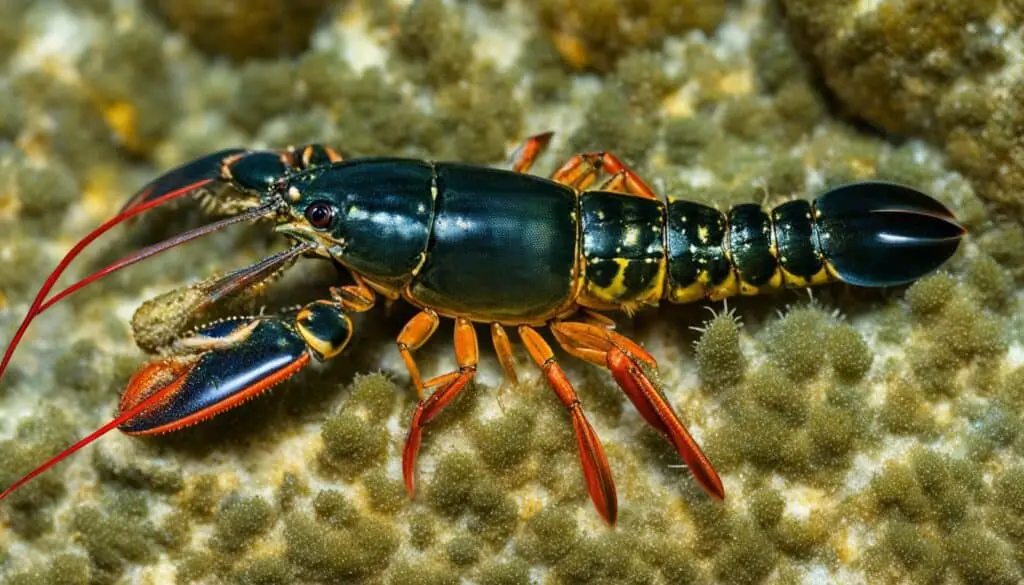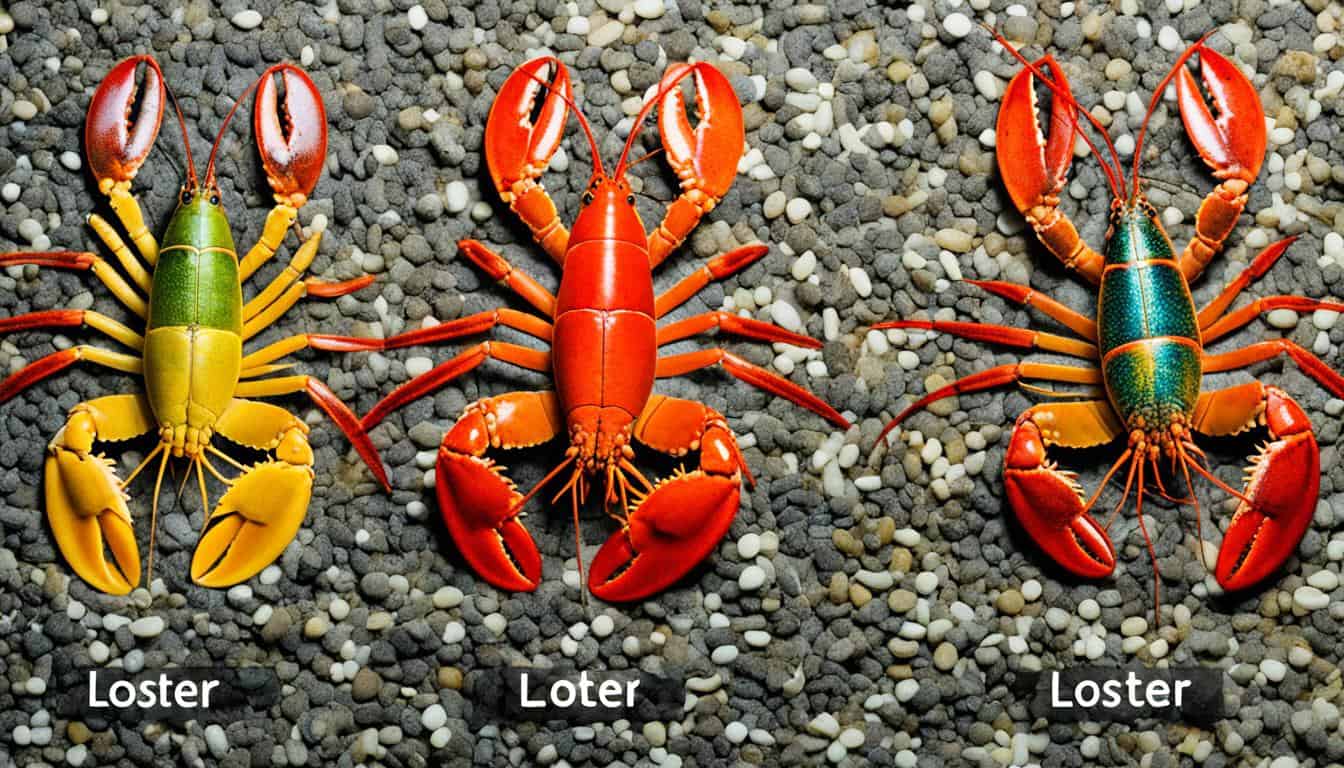Ever thought about how long lobsters live? These marine animals can live for many years, sometimes over 50. Their long lives make us curious about their biology and how they survive in different places. Let’s dive into the world of lobsters and see what makes them live so long.
Understanding Lobster Lifespan
Lobsters live a long time due to many factors. Their biology and the environment play big roles in how long they live. Things like water temperature, species, and growth stages matter a lot.
Lobster Longevity Insights
Cold-water lobsters live much longer than those in warmer waters. The American lobster is a great example. They can live over a hundred years in the cold Atlantic.
This is because they grow slowly in cold water. This slow growth means they can live longer and grow bigger.
Comparative Lifespan of Different Lobster Species
Each lobster species has its own life expectancy. Let’s look at a few:
| Species | Average Lifespan | Habitat |
|---|---|---|
| American Lobster (Homarus americanus) | 50-100 years | North Atlantic |
| Caribbean Spiny Lobster (Panulirus argus) | 5-20 years | Caribbean Sea |
| European Lobster (Homarus gammarus) | 50-80 years | North Atlantic |
| Rock Lobster (Jasus spp.) | 20-30 years | Southern Hemisphere |
How Long Do Lobsters Live?
Lobsters live longer in the wild than in captivity. Their life expectancy varies greatly between their natural and domestic environments. This section will explore how long lobsters live in the ocean versus in captivity.
Age Estimates in the Wild
Lobsters can live over a hundred years in the wild. Their long life depends on avoiding predators and staying healthy. Without threats, lobsters can live a long time.
Lobster Lifespan in Domestic Settings
Lobsters in captivity don’t live as long as those in the wild. They are usually harvested in 4 to 18 months, weighing about 1 pound. Captivity is stressful for them, leading to a shorter life.
| Setting | Estimated Lifespan | Weight at Harvest |
|---|---|---|
| Wild | Over 100 years | N/A |
| Domestic | 4 to 18 months | ~1 pound |
Factors Affecting Lobster Aging
Lobster aging is a complex process affected by many environmental and biological factors. These factors help us understand why lobsters live longer or shorter lives and their overall health.
Water temperature is a big factor. In cold water, lobsters move slower and live longer. They grow and mature more. But in warm water, they move faster and might not live as long.
How much food they get is also key. Eating well helps them grow strong and fight off diseases. This can make them live longer.
Being eaten by predators is another big factor. If there are fewer predators, lobsters can live longer. But, fishing can hurt their numbers and how long they live.
Diseases are a big concern too. When diseases spread, they can kill many lobsters. This affects how long they live. Fisheries management tries to keep a balance to help lobsters age naturally.
Lobster Life Expectancy Across Species
Looking at lobster life expectancy shows big differences across species. The American lobster and Caribbean lobster are great examples. Their homes greatly affect how long they live and their health.
A Look at American Lobster vs. Caribbean Lobster
The American lobster can live up to 50 years or more in the North Atlantic’s cold waters. This is much longer than the Caribbean lobster, which lives about 5 to 7 years. The warm oceans make the Caribbean lobsters’ lives shorter.
Environmental Influences on Lifespan
Many things in the environment affect how long lobsters live. Water temperature is a big one. Cold, clean waters help lobsters live longer, but warm, dirty waters shorten their lives.
Other things like salt levels and where they live also change lobster lifespans. Knowing how the environment affects lobsters shows why we need to protect them.
https://www.youtube.com/watch?v=88-epEAdjE4
The Myth of Lobster Immortality
The idea that lobsters can live forever is a popular myth. It says they keep growing and living forever. But, lobsters do age like all living things, facing many factors that affect their life span.
Lobsters grow by shedding their shells and getting new, bigger ones. This lets them get bigger, but it doesn’t stop aging. As they get older, they have trouble molting, which affects their health and survival.
Environmental factors also play a big part in how long lobsters live. They face predators, habitat issues, and changes in water quality. These challenges show that lobsters aren’t immortal. They live longer than some sea creatures but still age naturally.
In short, the idea of lobster immortality is too simple. By understanding how lobsters grow and face challenges, we can see the truth about their lives. This gives us a better view of their amazing world.
Growth Patterns and Their Impact on Longevity
Lobsters have amazing growth patterns that affect how long they live. Their life cycle includes the molting process, which is key for their growth. Lobsters grow without stopping throughout their lives, unlike many other animals that stop growing at a certain size.
Molting Process in Lobsters
The molting process lets lobsters grow by shedding their hard outer shell. Young lobsters molt often, sometimes many times a year. But older lobsters molt less. During molting, they are at risk from predators and other dangers, making their growth both thrilling and risky.
The Role of Indeterminate Growth in Lifespan
Indeterminate growth means lobsters can keep getting bigger as they age. This helps them mate and survive better in their environment. But, molting can be dangerous, affecting how long they live. Learning about lobster growth shows how complex and strong these creatures are.

| Growth Stage | Frequency of Molting | Growth Implications |
|---|---|---|
| Juvenile Lobster | 4-5 times a year | Rapid growth and increased vulnerability |
| Sub-Adult Lobster | 2-3 times a year | Growth rate slows, but still significant |
| Adult Lobster | Once a year or less | Size increase continues, but risk remains during molt |
Lobster Survival Rate in Natural Habitats
The lobster survival rate in natural habitats varies a lot. These crustaceans face many challenges like predators, changing environments, and fishing. Young lobsters have a hard time surviving, making them very vulnerable.
As lobsters grow and get bigger, their chances of living longer increase. Moving from being young to adult size is key to their survival in the wild. Big lobsters can avoid predators better and compete for food more effectively.
Natural habitats are crucial for lobsters. They need places with lots of shelter, like rocky spots and seagrass beds. These places protect them from predators and give them food. All these things help lobsters live longer.
| Life Stage | Survival Rate | Key Influences |
|---|---|---|
| Juvenile | Low | Predators, environmental changes |
| Adult | High | Size, habitat quality |
Learning about these things helps us understand lobster populations better. It shows how the environment affects their survival rates in different places.
Research and Discoveries on Lobster Aging
Research on lobster aging is uncovering new insights into their lives. Scientists have found that lobster stomach teeth could be key to figuring out their age. These teeth have growth rings, like those in trees, which help scientists understand how long lobsters live.
These findings are important for both science and managing lobster populations. They help us know how to keep lobster numbers healthy in the wild. By studying lobsters, we learn more about their lives and how to protect their homes.
Technology and new methods are making lobster aging research better. We can look forward to more discoveries that will help us understand lobsters better. This will be good for the ocean and fishing industries.
FAQ
How long do lobsters typically live?
In cold Atlantic waters, lobsters can live over 100 years. The Caribbean spiny lobster lives about 20 years. Their lifespan depends on things like water temperature and how fast they metabolize food.
What factors influence lobster aging?
Many things affect how long lobsters live, like water temperature, food, and predators. Cold water makes them live longer by slowing down their metabolism.
Can lobsters live in captivity longer than in the wild?
No, lobsters usually don’t live as long in captivity as they do in the wild. In captivity, they face stress and different environments. They are often caught and eaten within 4 to 18 months of age.
Are there differences in lifespan between lobster species?
Yes, the American lobster lives much longer than the Caribbean lobster. The American lobster lives in colder waters, which helps it live longer.
Do lobsters experience immortal aging?
Lobsters do age, despite some myths saying they don’t. They grow in unique ways but are still affected by aging, predators, and the environment.
What is the molting process in lobsters?
Molting is when lobsters shed their hard outer shell to grow. It happens more often in young lobsters and less as they get older. This process makes them more vulnerable during that time.
How do environmental conditions affect lobsters’ survival rates?
Lobsters’ survival rates change a lot based on their environment, predators, and fishing. They need good places to live with enough shelter and food to survive.
What recent discoveries have been made regarding lobster aging?
Scientists have recently studied lobster stomach teeth. These teeth might help tell how old lobsters are, like tree rings do. This research is important for understanding lobster populations and helping conservation efforts.







